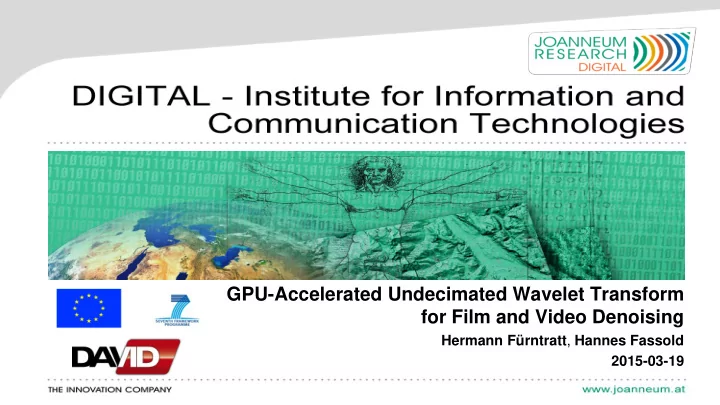

GPU-Accelerated Undecimated Wavelet Transform for Film and Video Denoising Hermann Fürntratt , Hannes Fassold 2015-03-19
Overview 2 GPU-activities @ AVM research group Undecimated Wavelet Transform Algorithm GPU Implementation Application example Film and Video denoising
Overview 3 GPU-accelerated algorithms / applications @ AVM AVM - AudioVisual Media research group, DIGITAL – Institute for Information and Communication Technologies, JOANNEUM RESEARCH Content-based video quality analysis http://vidicert.com Digital film restoration http://www.hs-art.com Brand monitoring http://www.branddetector.at GPU activities since 2007 - using CUDA C++ Sucessfully ported complex computer vision algorithms like KLT feature point tracking, SIFT descriptor extraction or Semi-Global Matching to the GPU
Undecimated Wavelet Transform (1) 4 Discrete Wavelet Transform (DWT) widely used E.g. in image compression (JPEG 2000) Undecimated Wavelet Transform (UWT) Also known as Stationary Wavelet Transform, Shift-Invariant Discrete Wavelet Transform, Overcomplete Discrete Wavelet T ransform, see [Fowler2005] … UWT is nearly the same as DWT, but the sub-sampling step is skipped All wavelet components in all levels have the same size as the input image Three wavelet components (LH, HL, HH) per level Much better suited than DWT for all sort of image enhancement tasks Denoising, deblurring, superresolution , … Main disadvantage is the significantly higher computational complexity
Undecimated Wavelet Transform (2) 5 UWT implementation Calculated with ‚a trous ‘ algorithm Key routines used in each level Convolution with two 1-D row or 1-D column kernels (one input image, two output images) Convolution with one 1-D row or 1-D column kernel Convolution kernel Kernel size is growing for each level Convolution kernel is getting progressively more ‚ sparse ‘
Undecimated Wavelet Transform GPU Implementation (1) 6 Goals Flexibility Support for different wavelet classes (Haar wavelets, Daubechies wavelets , …) and different datatypes (16-bit float, 32-bit float) Maintainability Performance Design principles of GPU implemention Loosely based on principles mentioned in [Iandola2013] Load directly into register via ‚ texture path ‘ Computation of multiple outputs per thread (parameter ‚ grainsize ‘) Make it easy for compiler to unroll the innermost convolution loop by hard-coding loop bounds & loop increment
Undecimated Wavelet Transform (2) 7 GPU implementation Templatized CUDA kernel Template parameters: datatype, convolution kernel radius, loop increment, grainsize Algorithm workflow For certain kernel radii and loop increments, the templatized CUDA kernel is called A big switch clause with multiple case statements Convolution kernels which are not symmetric (e.g. Haar wavelets) are extended to the next bigger symmetric convolution kernel for which a kernel call is available within the case statement
Undecimated Wavelet Transform (3) 8 GPU implementation – some more notes Constant memory is very useful Texture path very useful Makes CUDA kernels much more straightforward (no explicit handling of border pixels necessary , …) Texture objects are very convenient (CC >= 3.0 necessary) Good performance (good caching behavior) also for pitch-linear 2-D memory Unrolling of innermost convolution kernel is very important Disabling it makes CUDA kernel two times slower Usage of 16-bit floats increases performance ~ 30 - 40%
Runtime comparison (1) 9 CPU implementation In-house C++ reference implementation Multi-threaded using OpenMP Quality tests Differences between GPU and CPU implementation are negligible Test setup for runtime tests CPU: Xeon E5-1620 Quad-Core @ 3.6 GHz GPU: NVIDIA GeForce GTX 770 Transfer time (CPU – GPU memory) not included
Runtime comparison (2) 10 Speedup factor GPU vs CPU implementation 70 64 60 2K: 2048 x 1556 4K: 4096 x 3112 51 50 47 GPU: GTX 770 40 1536 cores 32 @ 1.046GHz 30 CPU: Xeon E5-1620 4 cores 20 @ 3.6GHz 10 0 Float32@2K Float32@4K Float16@2K Float16@4K
Film and video denoising (1) 11 Noise Can be often observed in both film (as film grain) and digital video (as digital sensor noise) Degrades viewing experience considerably Lowers the compression ratio when encoding noisy content Noisy versions of ‚Lena‘ showing fine noise and coarse noise
Film and video denoising (2) 12 Typical workflow of a wavelet-based denoising algorithm Apply wavelet transform to one image or a (usually motion-compensated) 3-D spatiotemporal volume Shrink insignificant (small-magnitude) wavelet coefficients towards zero Apply inverse wavelet transform A practically usable denoising algorithm includes much more steps Must be able to estimate the noise type (magnitude, coarseness, signal-dependency) automatically Must have safeguards against motion-compensation errors
Film and video denoising (3) 13 Novel denoising algorithm developed at AVM group Automatically estimates noise characteristics Is therefore able to adapt to the actual noise type (film grain, digital sensor noise, …) Two-phase approach Uses motion-compensated 3-D volume Evaluation results Generated novel dataset where realistic noise was added with texture synthesis method Evaluation shows that algorithm is competitive with best algorithm from academics CV-BM3D [Dabov2007] < DEMO VIDEO (SPLIT-SCREEN) FOLLOWS >
References 14 [Dabov2007] K. Dabov, A. Foi, K. Egiazarian, “Video denoising by sparse 3d transform-domain collaborative ltering ”, Proc. 15th European Signal Processing Conference (EUSIPCO), Poznan, Poland, 2007 Matlab implementation of CV-BM3D available for non-profit scientific research purposes at http://www.cs.tut.fi/~foi/GCF-BM3D/index.html#ref_software [Fowler2005] J. Fowler, „ The Redundant Discrete Wavelet Transform and Additive Noise”, IEEE Signal Processing Letters, Volume 12, 2005 [Iandola2013] F. Iandola, D. Sheffield, M. Anderoson, P. Phothilimhana, K. Kreutzer, „Communication -minimizing 2D convolution in registers “, Proc. IEEE International Conference on Image Processing, Melbourne, Australia, 2013.
Acknowledgments 15 Thanks to the Flemish Radio and Television Broadcasting Organization (VRT, Belgium) for providing the video "elfenheuvel" for research and demonstration purposes. Thanks to the BM3D authors (K. Dabov, A. Foi, K. Egiazarian, Tampere University of Technology) for making available the Matlab code of the CV-BM3D algorithm for non-profit scientific research purposes. The research leading to these results has received funding from the European Union's Seventh Framework Programme (FP7/2007-2013) under grant agreement no. 600827, DAVID (“Digital AV Media Damage Prevention and Repair''). http://david-preservation.eu/
Thank you for your attention Hermann Fürntratt, Hannes Fassold JOANNEUM RESEARCH Forschungsgesellschaft mbH hermann.fuerntratt@joanneum.at Institute for Information and hannes.fassold@joanneum.at Communication Technologies www.joanneum.at/digital
Recommend
More recommend